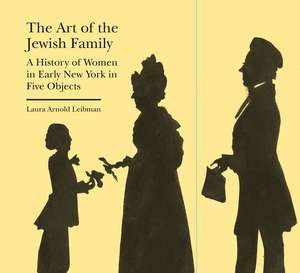The Art of the Jewish Family: A History of Women in Early New York in Five Objects: Bard Graduate Center - Cultural Histories of the Material World
Autor Laura Arnold Leibmanen Limba Engleză Hardback – 30 iun 2020
Each chapter creates a biography of a single woman through an object, offering a new methodology that looks past texts alone to material culture in order to further understand early Jewish American women’s lives and restore their agency as creators of Jewish identity. While much of the available history was written by men, the objects that Leibman studies were made for and by Jewish women. Speaking to American Jewish life, women’s studies, and American history, The Art of the Jewish Family sheds new light on the lives and values of these women, while also revealing the social and religious structures that led to Jewish women being erased from historical archives.
The Art of the Jewish Family was the winner of three 2020 National Jewish Book Awards: the Celebrate 350 Award for American Jewish Studies, the Gerrard and Ella Berman Memorial Award for History, and the Barbara Dobkin Award for Women's Studies.
Preț: 163.13 lei
Preț vechi: 201.99 lei
-19% Nou
Puncte Express: 245
Preț estimativ în valută:
31.22€ • 33.38$ • 26.03£
31.22€ • 33.38$ • 26.03£
Carte indisponibilă temporar
Doresc să fiu notificat când acest titlu va fi disponibil:
Se trimite...
Preluare comenzi: 021 569.72.76
Specificații
ISBN-13: 9781941792209
ISBN-10: 1941792200
Pagini: 350
Ilustrații: 102 color plates, 6 tables
Dimensiuni: 152 x 229 x 36 mm
Greutate: 0.68 kg
Ediția:1
Editura: BARD GRADUATE CENTER
Colecția Bard Graduate Center
Seria Bard Graduate Center - Cultural Histories of the Material World
ISBN-10: 1941792200
Pagini: 350
Ilustrații: 102 color plates, 6 tables
Dimensiuni: 152 x 229 x 36 mm
Greutate: 0.68 kg
Ediția:1
Editura: BARD GRADUATE CENTER
Colecția Bard Graduate Center
Seria Bard Graduate Center - Cultural Histories of the Material World
Notă biografică
Laura Arnold Leibman is professor of English and humanities at Reed College.
Recenzii
“From the moment this book opens as Judith de Mereda steps off a ‘creaky deck’ and into ‘muddy streets,’ we know that we are in the hands of a terrific writer. In this brilliantly researched and richly illustrated book, we journey to New York City in the century between 1750 and 1850. . . . She discovers America’s Jewish women shaping ‘the emotional landscape of American Judaism.’ Moreover, her pathbreaking volume commands that attention be paid to material culture in future writing about American Jewish history.”
“It’s a measure of the author’s gifts, both as a scholar and as a storyteller, that we come to know these women, their families, and the Jewish communities in which they lived with astonishing clarity and intimacy. Leibman richly deserves the widespread acclaim — and, even more so, the affection — that her remarkable book has attracted.”
“In each instance, Leibman admirably demonstrates how these artifacts voice the aspirations, values, and contributions of Jewish American women of the eighteenth and nineteenth centuries.”
"Complementing and enlivening the narrative, not just accompanying it, the volume’s 96 images encompass painting, portraiture, and maps—a bonanza of visual information. Just when we’ve come to believe we know all there is to know about the early experiences of colonial and federal-era American Jews, Leibman reminds us how much more could be known if only we would deploy a different set of sources and ask a different set of questions. Through five sharply focused case studies, she takes her readers beyond the usual places—New York and Charleston, say—and sets them down in Barbados and Suriname of the 18th and early 19th centuries, whose robust Jewish life rendered that of the American colonies a poor cousin. . . . A harvest of ideas, The Art of the Jewish Family yields a rich ensemble profile of Jewish women of the 18th and 19th centuries, an invigorating consideration of history as a process, and a compelling argument for integrating material culture as a matter of course into any and all historical projects."
"From an ivory miniature to a set of silver cups, the objects discussed in this book all attest to how women in New York from 1750-1850 harnessed material culture to explore and express their Jewish identity."
"Liebman does a wonderful job not only showing the changes in women’s status over time, but the roles race and class play in a person’s life. While those interested in women’s studies are the most obvious audience for this work, anyone who wants to better understand early American history--Jewish or otherwise–will find Liebman’s book has a great deal to offer."
"This is a deeply-researched book and surprisingly fun read."
“This is a pathbreaking volume by a master scholar.”
“The Art of the Jewish Family is an elegantly written, astonishingly researched, and persuasively argued collective biography of five early American, New York Jewish women. . . . From the moment that the book opens, we know that we are in the hands of a terrific writer. . . . Leibman’s detailed analyses of the messages encoded in the objects is brilliant. . . . Given the power of the material and the grace of the writing, I would hope that this book would reach beyond scholars to the significantly wider audience of those outside the academy who are deeply interested in early American history. . . . I am in awe of Leibman’s accomplishment."
"Leibman convincingly demonstrates that scholars of American Jewish history have neglected the study of early American Jewish women, especially those who were not very wealthy or conventionally important; even more crucially, though, she guides
readers through a methodology for dealing with the archival absences that have led to this neglect. Leibman’s astoundingly careful material culture analysis shows us how much we have missed."
readers through a methodology for dealing with the archival absences that have led to this neglect. Leibman’s astoundingly careful material culture analysis shows us how much we have missed."







